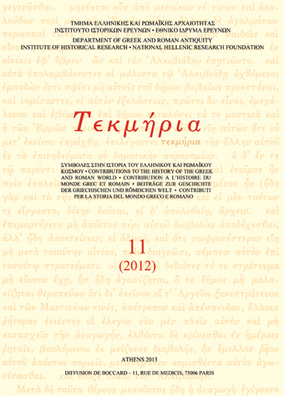Τὸ ρωμαϊκὸ ἐργοστάσιο ὅπλων (fabrica) τῆς Θεσσαλονίκης : Μία νέα ἐπιγραφή
Part of : Τεκμήρια ; Vol.1, 1995, pages 66-78
Issue:
Pages:
66-78
Parallel Title:
The Roman arms factory (Fabrica) in Thessaloniki : A new inscription
Section Title:
Articles
Author:
Abstract:
The fabrica in Thessaloniki was hitherto known to us from a single reference in the Notitia Dignitatum. The text published here confirms its existence in the 4th century AD. It is an inscription on a sarcophagus that was bought by a married couple with money they had earned together. The husband describes himself as a soldier registered on the rolls of the workers in a state arms factory, which logically must be the one in the city. This was probably the only post he had ever held, at least thus far in his career. An obvious terminus post quern for the inscription is the earliest possible time when the arms factory could have been established, i.e. Diocletian's reign, which was when the first fabricae appeared. The terminus could perhaps be shifted by a couple of decades —to the early 4th century AD— if, as seems likely, the soldier mentioned in the inscription was close to the end of his service (the purchase of a sarcophagus suggests a person of mature years) and if he had never served anywhere else. A terminus ante quern is more difficult to determine; though the fact that the fine for violating the sarcophagus is specified in denarii is an indication that the inscription should be dated to before the 5th century AD. The practice seems gradually to have been abandoned throughout the Empire in the 4th century AD, owing to inflation. Already by the end of the 3rd century, owners of tombs were starting to stipulate the relevant fines in terms of weight of precious metal (so many pounds of gold or silver, for instance). The abbreviation that follows the symbol for denarii admits of two readings: μύρι(α) or μυρι(άδας). In the first case the fine would be 10.500 denarii, in the second 5.000.000. In view of the relatively late date of the inscription, the latter seems more likely. In Thessaloniki, as elsewhere in the Empire, sepulchral fines gradually increased in the 3rd century, because of inflation, so that at this time fines ranging from 50.000 to 120.000 denarii are attested in the city. In fact there are two known cases, of sarcophagi that probably date from the late 3rd or the 4th century, in which the very large sums of 500.000 and 1.300.000 denarii are stipulated. Although rare, fines of this magnitude, expressed in denarii, are by no means unknown in such inscriptions in the 4th century AD in the Empire as a whole. Palaeographic data, and particularly the inscription's internal evidence, enable us to date it, with relative certainty, to the 4th century AD. If, as seems probable, the amount of the fine is indeed 5.000.000 denarii, it would be risky to attempt a more precise dating within that century. The most likely period, however, seems to be the time of rapid inflation, i.e. the 3rd or 4th decade. A later dating would make the fine improbably low, owing to the continuing rise of inflation.
Subject:
Subject (LC):




